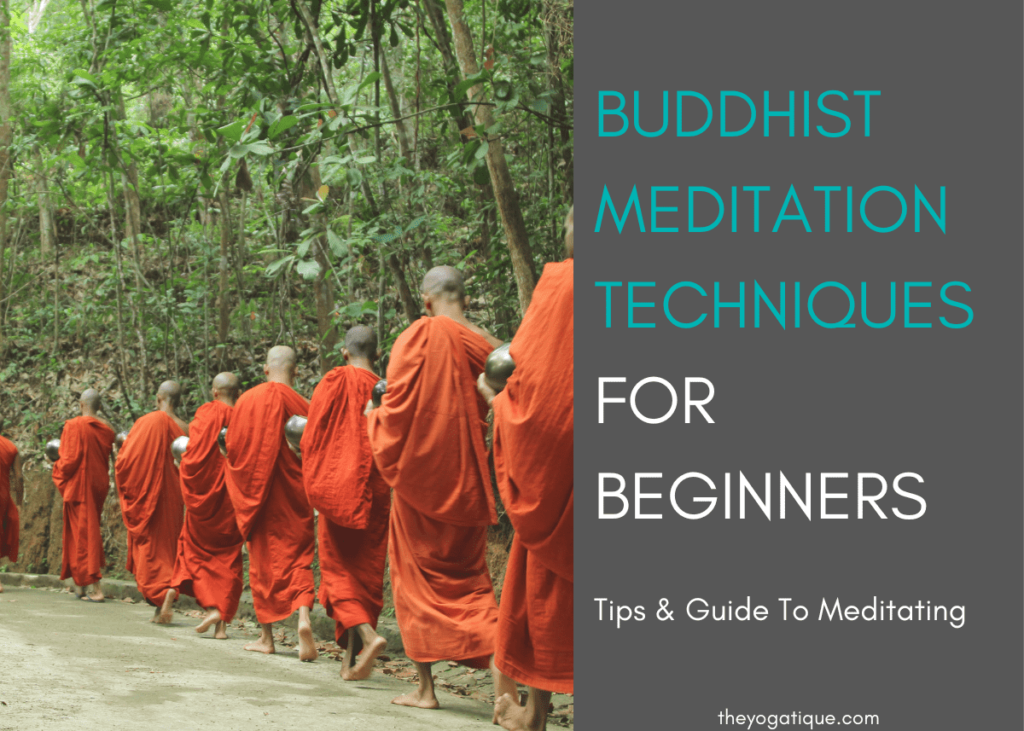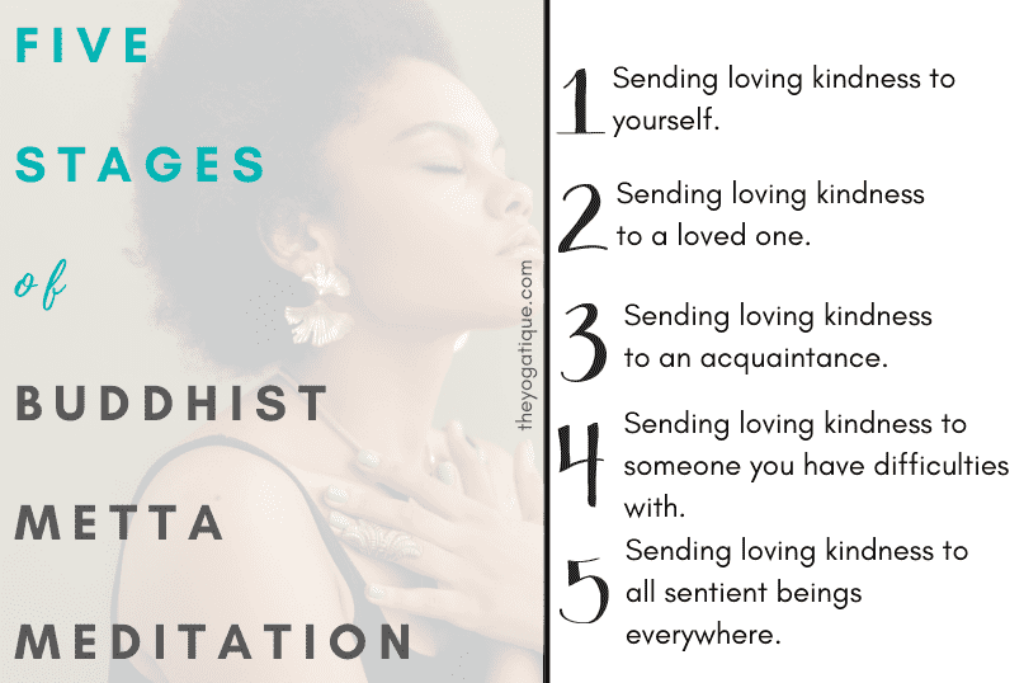
As an avid meditator who has spent much time in Buddhist countries like Thailand, I became increasingly interested in learning Buddhist meditation techniques. One day I gave into my curiosity and signed up for a Buddhist meditation course at a monastery in Bangkok.
Here I discovered the three main Buddhist meditation techniques, and under the guidance of a wise monk, I learned how to practice them. While the course only lasted a few days, I took away much knowledge and advice to help me continue my meditation journey.
If you’re keen to learn Buddhist meditations but cannot commit to a residential stay at a monastery, don’t worry.
In this guide, I’m sharing three Buddhist meditation techniques for beginners and how to do them. And be sure to read until the end for my guided meditation script and top tips for practicing mindfulness meditation.
Article content:
(Click any link below to jump directly to section)

BECOME A CERTIFIED MEDITATION TEACHER
Online Meditation Teacher Training Offers
- Affordability
- Flexibility
- Certification
- Lifetime access
⬇Click below to discover the best online meditation teacher trainings enrolling now⬇
What is the purpose of meditation in Buddhism?
Meditating can reduce negative thoughts while increasing mental clarity. A clear and focused mind is essential for achieving awakening or enlightenment, which is the goal of Buddhism.
Meditation develops wisdom, self-awareness, and compassion while helping you connect to the present moment. Meditation is an integral part of Buddhism for all Buddhist practitioners, not just monks.
Buddha taught that when you reach the highest form of enlightenment, called nirvana, all negative karma, self-attachment, and ego are dissolved. When this happens, you return to your true nature and experience eternal inner peace.
Therefore, Buddha taught meditation practice as the pathway to nirvana. As there are four stages of enlightenment before nirvana (Sotapanna, Sakadagami, Anagami, and Arahant), practicing meditation can help you slowly advance through each step.
3 tips for beginners to learn Buddhist meditation
If you are a beginner and interested in learning Buddhist meditation practices, here are a few tips for ensuring you get the most from this mindful practice.
- Attend a Buddhist meditation class – Many Buddhist centers offer guided meditation classes and dharma talks for beginners. If you have a Buddhist center nearby, ask if they offer something like this. Learning from Buddhist meditation teachers in person allows you to ask questions about the practice and clarify anything you don't fully understand.
- Practice mindfulness in daily life – Buddhist meditation is a form of mindfulness, but there are other ways to connect to the present moment besides meditation. Bring mindfulness into small daily tasks like making tea and brushing your teeth. While doing these activities, bring full awareness to your senses and practice mindful breathing.
- Set up a comfortable meditation space – Having a comfortable, quiet place to meditate is vital to a successful meditation practice. Do your daily practice somewhere without distractions, like an office or spare room. Invest in a high-quality meditation pillow to minimize physical discomfort and use soft lighting. You may also like to light incense or diffuse essential oils to promote feelings of calm and inner peace.
3 types of meditation in Buddhism
Various Buddhist meditation techniques and other types of meditation, like Vedic meditation, are suitable for beginners.
Here are the three Buddhist meditation practices I learned in the monastery and still practice today.
1. Vipassana (insight Meditation)

Vipassana is the most commonly known Buddhist meditation practice, with over 200 Vipassana meditation centers worldwide offering their traditional 10-day silent retreat. The Palinese word Vipassana means ‘to see things as they really are’ but can also translate as ‘insight.’
Vipassana is an ancient sitting meditation practice first mentioned in the Satipatthana Sutta (The Discourse on the Establishing of Mindfulness). In the Western world, Vipassana is commonly referred to as mindfulness meditation as its aim is similar, to observe your thoughts and emotions without judging or trying to understand them.
Vipassana is a gentle breathing meditation practiced in a seated position where you bring your awareness and focus to your breath.
- Either focus on the sensation of the breath in your body (such as the belly and chest movements) or the air entering and leaving your nostrils.
- Keep your breath natural, and try to remain mindful of each inhale and exhale.
- Whenever you notice your mind becoming distracted, simply observe that distraction and return to your breath.
- Similarly, observe any thoughts, feelings, and sensations that arise during the practice without reacting to them or judging yourself for being unable to stay focused. This is all part of the practice!
2. Zen walking (walking meditation)

Zen walking is one of the most accessible Buddhist meditation techniques for beginners, as many people struggle to sit in a cross-legged position. With this meditation technique, you can practice meditating while moving slowly and mindfully.
Traditionally, you practice zen walking by walking back and forth in a short, straight line. I learned this technique in a relatively small room, where we would walk in a line from one wall to another.
The technique is to break your foot movements down into three separate actions; lifting the foot, moving the foot, and placing the foot down. You should also lift and place the foot very slowly, feeling the sensation of each part of the foot touching the floor.
You can do this meditation technique inside or outside, wherever you have about 40 feet of space in length. If possible, I recommend doing this practice barefoot to increase the sensation you feel.
- As you lift, move, and land your foot, mentally label the movement, like ‘lifting,’ ‘moving,’ and ‘landing.’ This will help you stay focused.
- When placing your foot back down, first release the heel, then the ball of the foot, then the toes.
- When you reach the end of your path (or a wall), slowly turn while mentally labeling the movement ‘turning’ before mindfully walking back the other way.
- Keep your eyes open but your gaze down towards your feet.
3. Samatha (concentration meditation)

The aim of Samatha is to increase concentration. The word Samatha translates as ‘concentration’ or ‘tranquility.’ While the goal of Vipassana is to gain insight, the goal of Samatha is improve concentration. Thus, it is also known as concentration meditation.
In some schools of Buddhism, Samatha is taught as a preparation for Vipassana. It is one of the best meditations for beginners as it helps to train the mind and break free from overthinking, making it a very beneficial practice for mental health.
To develop concentration through Samatha, you attain a focal point, commonly the breath or a mantra.
If focusing on the breath, you observe the belly and chest rising and falling, similar to in Vipassana. When focusing on a mantra, mentally recite or chant the words aloud throughout the practice.
Many people find using a mantra helps them stay focused and present easier than with breath awareness.
You can use various Buddhist mantras, but the most common and powerful Buddhist mantra is Om Mani Padme Hum. Om Mani Padme Hum is commonly translated as “the jewel is in the lotus,” it is believed to contain the power to help the meditator attain pure body, speech, and mind.
Om Mani Padme Hum is also a calming mantra used to alleviate fears, anxiety, and emotional pain. Interestingly, Om Mani Padme Hum is also known as the six true words as the six syllables (Om Ma Ni Pad Me Hum) are said to bring joy and peaceful vibrations.
What is guided Buddhist meditation?
Traditionally, Buddhist meditation practices are done independently. However, you will likely need some guidance when you first start practicing meditation. Therefore, I recommend using guided meditations for the styles described above before you try practicing them on your own.
This 10-minute guided practice by Buddhist meditation master Niels is an excellent introduction to the Vipassana technique.
One of my favorite guided Buddhist meditation techniques is Metta Meditation, also known as loving-kindness meditation. The benefits of metta meditation are also covered in meditation teacher training online if you're keen to dive deeper into this style.
The Buddha taught loving-kindness meditation to help practitioners cultivate positive emotions like love, compassion, empathy, and kindness to themselves and others.
A common Buddhist metta meditation practice involves five stages:

- Sending loving kindness to yourself
- Sending loving kindness to a loved one
- Sending loving kindness to an acquaintance
- Sending loving kindness to someone you have difficulties with
- Sending loving kindness to all sentient beings everywhere
Here is a guided metta meditation you can try yourself:
Sit cross-legged in a comfortable posture, using pillows to prop yourself up. With your eyes closed, consciously relax your entire body. Start from the head and work your way down, softening each body part as you go.
Bring your awareness to your breathing. Notice your natural in-breath and out-breath, and feel the movement of your chest and belly. Spend a few minutes observing both your in and out breaths until you feel a sense of peace and calmness in your mind.
Place your right hand on your heart and bring a picture of yourself to mind. You may like to envision yourself as a child, teenager, or yourself today. With this image in mind, repeat the words, “May I be well, may I be happy, may I be free from suffering.” Repeat this three times or until you feel self-love within you.
Next, imagine a loved one, such as a partner, parent, child, close friend, or pet. With their image
in mind, repeat the words, “May you be well, may you be happy, may you be free from suffering,” like you are saying them directly to your loved ones. Repeat this as many times as you feel is necessary.
Next, bring to mind an image of an acquaintance, someone you often see in everyday life but do not know well. This could be a shop worker, bus driver, or a work colleague. With their image in mind, repeat the words, “May you be well, may you be happy, may you be free from suffering” as many times as you feel necessary.
Now bring to mind an image of someone you have a complicated relationship with. Imagine you're talking to them directly as you say, “May you be well, may you be happy, may you be free from suffering.” This is often the most challenging stage, so you may have to repeat the words for several minutes until you feel compassion and kindness in your heart for this person.
Finally, imagine you are divine energy looking down on yourself. Slowly zoom the image out of the room, building, street, town, and country you are in until you have a view of the entire world and all its living beings. Repeat the phrase “May all beings be well, may all beings be happy, may all beings be free from suffering” three times.
Return to your breathing and body, feeling your sitting bones grounding into the earth. When you are ready, open your eyes.
Takeaway on Buddhist meditation techniques for beginners
Buddhist meditation is accessible and inclusive to all. You don't have to be an advanced meditator or strict Buddhist to reap the many health benefits of these Buddhist meditation techniques for beginners.
Still, remember that meditation is a practice and something you cannot master overnight. Be patient and compassionate toward yourself when you notice your mind wanders or negative emotions come up. You've got this!
FAQ about Buddhist meditation
How do I start meditation in Buddhism?
The keys to starting a meditation practice are consistency and patience. If you are only able to meditate for five minutes in the beginning, accept that. Gradually you will be able to meditate for longer periods of time with practice.
What are the four C's of meditation?
The four c's of meditation are concentrate, consider, converse and commit.
Some online yoga studios, online yoga teacher training programs, and brands that we write about may offer us a small commission should you decide to make a purchase or signup after reading our content. Thank you for enabling us to exist!






